Middle School
Math
M/J Grade 6 Mathematics FDE
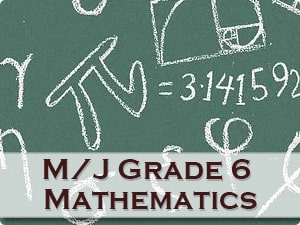
This course builds a foundation of high school Math skills that can be built upon in more advanced Math courses. Topics in this course include: ratio reasoning; multiplication and division; divide fractions by fractions; common factors and multiples; rational numbers; number line; arithmetic to algebraic expressions; solve one-variable equations and inequalities; dependent and independent variables; area, surface area, and volume; nets; statistical variability; plots and distributions.
M/J Grade 7 Mathematics FDE
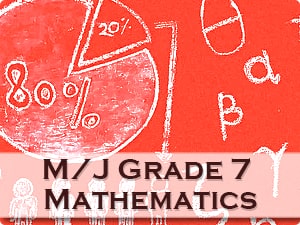
This course builds a foundation of high school Math skills that can be built upon in more advanced Math courses. Topics in this course include: recognizing that fractions, decimals and percentages are different representations of rational numbers and performing all four operations with rational numbers with procedural fluency; creating equivalent expressions and solving equations and inequalities; developing understanding of and applying proportional relationships in two variables; extending analysis of two- and three-dimensional figures to include circles and cylinders and representing and comparing categorical and numerical data and developing understanding of probability.
M/J Grade 8 Pre-Algebra FDE
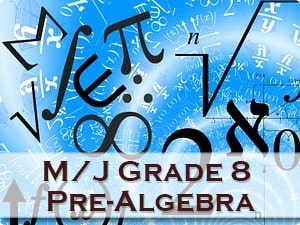
This course builds a foundation of high school Math skills that can be built upon in more advanced Math courses. Topics in this course include: Rational and irrational numbers; radicals and integer exponents; proportional relationships, lines, and linear equations; analyze and solve linear equations, pairs of simultaneous linear equations; functions; model relationships between quantities; congruence and similarity; the Pythagorean Theorem; volume of cylinders, cones, and spheres; and investigate patterns of association in bivariate data.
M/J Intensive Mathematics (MC)
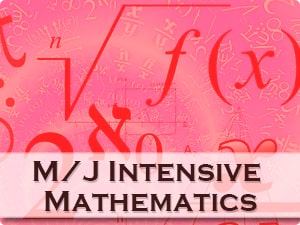
This course focuses on the understanding of polynomials and rational expressions, creating and solving equations, and reasoning with equations and inequalities. Students will also build various functions, interpret them using key features, and compare properties of two functions. Emphasis will be placed on constructing linear, quadratic, and exponential models. This course emphasizes the study of circles, construction of inscribed and circumscribed circles of a triangle, transformations, similarity and congruence, and proving theorems. Volume and surface area, cross sections, parallel and perpendicular lines, area and perimeter, and modeling with geometry are also emphasized. In addition, students will also work on trigonometric ratios, similarity, and application of right triangles. Emphasis will be placed on real number system and interpreting categorical and quantitative data.
ELA
M/J Language Arts 1 FDE
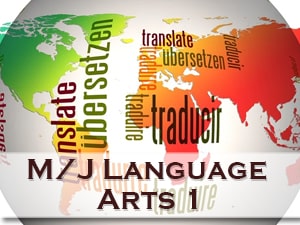
This course is designed to help students develop reading, literature, writing, and comprehension skills. Students read stories of various genres and understand the niches of identifying the main idea, theme, and other elements of story. Reading also encompasses understanding the author's purpose, analyzing the different points of view, and the importance of pictures and illustrations in texts. Strategies to improve vocabulary such as understanding prefixes and suffixes, word analogies, use of transitions, and connotation and denotation help students showcase their writing skills in different genres. Punctuation, pronouns and types, sentence patterns, etc. are also given emphasis in this course.
M/J Language Arts 2 FDE
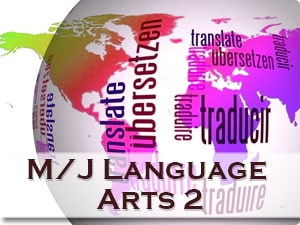
This course is designed to help students develop reading, literature, writing, and comprehension skills. Students read stories of various genres and understand the niches of identifying the main idea, theme, and other elements of story. Reading also encompasses understanding the author's purpose, analyzing the different points of view, and the importance of dialogs in stories. Strategies to improve vocabulary such as understanding prefixes and suffixes, word analogies, use of transitions, and connotation and denotation help students showcase their writing skills in different genres. Understanding the techniques of different types of writing helps students improve their writing skills.
M/J Language Arts 3 FDE
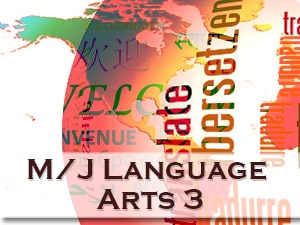
This course is designed to help students develop reading, literature, writing, comprehension, and grammar and language skills. Course topics include: Traditional Themes found in Modern Literature, Word Analogies, Inferences, Drawing Conclusions, Conjunctions, Significance of Conclusion to a Narration, Writing Techniques, Gerunds, Infinitives, Participles, Active and Passive Voice, Punctuation - Ellipses.
M/J Language Arts 1 Advanced
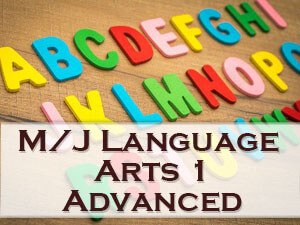
This course is designed to help students develop reading, literature, writing, and comprehension skills. Students read stories of various genres and understand the niches of identifying the main idea, theme, and other elements of story. Reading also encompasses understanding the author's purpose, analyzing the different points of view, and the importance of pictures and illustrations in texts. Strategies to improve vocabulary such as understanding prefixes and suffixes, word analogies, use of transitions, and connotation and denotation help students showcase their writing skills in different genres. Punctuation, pronouns and types, sentence patterns, etc. are also given emphasis in this course.
M/J Language Arts 2 Advanced
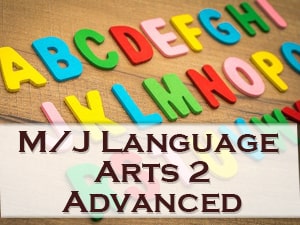
This course is designed to help students develop reading, literature, writing, and comprehension skills. Students read stories of various genres and understand the niches of identifying the main idea, theme, and other elements of story. Reading also encompasses understanding the author's purpose, analyzing the different points of view, and the importance of dialogs in stories. Strategies to improve vocabulary such as understanding prefixes and suffixes, word analogies, use of transitions, and connotation and denotation help students showcase their writing skills in different genres. Understanding the techniques of different types of writing helps students improve their writing skills.
M/J Language Arts 3 Advanced
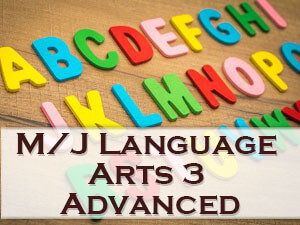
This course is designed to help students develop reading, literature, writing, comprehension, and grammar and language skills. Course topics include: Traditional Themes found in Modern Literature, Word Analogies, Inferences, Drawing Conclusions, Conjunctions, Significance of Conclusion to a Narration, Writing Techniques, Gerunds, Infinitives, Participles, Active and Passive Voice, Punctuation - Ellipses.
M/J Writing 1

This course is designed to help students develop reading, literature, writing, and comprehension skills. Students read stories of various genres and understand the niches of identifying the main idea, theme, and other elements of story. Reading also encompasses understanding the author's purpose, analyzing the different points of view, and the importance of pictures and illustrations in texts. Strategies to improve vocabulary such as understanding prefixes and suffixes, word analogies, use of transitions, and connotation and denotation help students showcase their writing skills in different genres. Punctuation, pronouns and types, sentence patterns, etc. are also given emphasis in this course.
M/J Writing 2
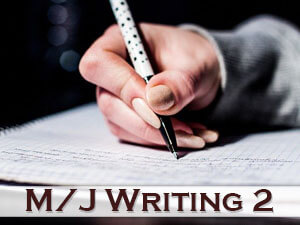
This course is designed to help students develop reading, literature, writing, and comprehension skills. Students read stories of various genres and understand the niches of identifying the main idea, theme, and other elements of story. Reading also encompasses understanding the author's purpose, analyzing the different points of view, and the importance of dialogs in stories. Strategies to improve vocabulary such as understanding prefixes and suffixes, word analogies, use of transitions, and connotation and denotation help students showcase their writing skills in different genres. Understanding the techniques of different types of writing helps students improve their writing skills.
M/J Writing 3
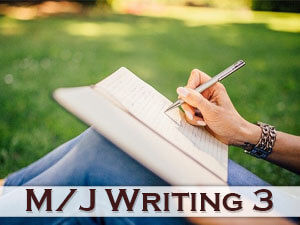
This course is designed to help students develop reading, literature, writing, and comprehension skills. Students read stories of various genres and understand the niches of identifying the main idea, theme, and other elements of story. Reading also encompasses understanding the author's purpose, analyzing the different points of view, and the importance of dialogs in stories. Strategies to improve vocabulary such as understanding prefixes and suffixes, word analogies, use of transitions, and connotation and denotation help students showcase their writing skills in different genres. Understanding the techniques of different types of writing helps students improve their writing skills.
Science
M/J Life Science FDE
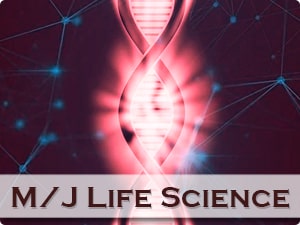
This course is the comprehensive study of concepts and principles related to the field of Science. Topics in this course include: This course is the comprehensive study of concepts and principles related to the field of Science.
M/J Earth/Space Science FDE
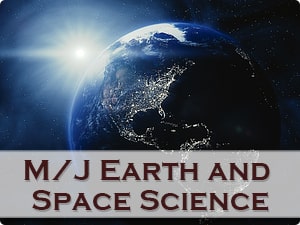
This course that covers an overview of the structure of the Earth, our solar system, galaxy and universe.
M/J Comprehensive Science 1 FDE
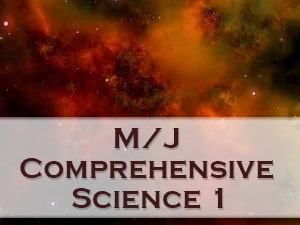
This course is the comprehensive study of concepts and principles related to the field of Science. Topics in this course include: This course is the comprehensive study of concepts and principles related to the field of Science. Topics in this course include: Factors Affecting Health, Geological Processes and Surface Features, Heat Transfer Through Earth's System, Weather, Climate, and Water Cycle, Earth's Spheres, Influences of Solar Energy on the Atmosphere, Effects of Natural Disasters in Florida, Earth's Atmosphere, Biosphere-Levels of Organization, Discovery of the Cell, Homeostasis, Cell Organelles, Body Organization, Communicable Diseases, Classification of Organism, Science Inquiry, Experimental Repetition and Replication, Merits and Demerits of Scientific Investigations, Conservation of Energy, Force and Motion, Types of Forces, and Newton's Law of Gravitation.
M/J Comprehensive Science 2 FDE
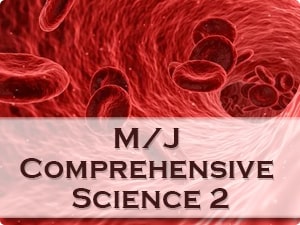
This course is the comprehensive study of concepts and principles related to the field of Science. Topics in this course include: Factors Affecting Health, Communicable Diseases, Structure of Earth, Rock Cycle and Surface Events, Measuring the Age of Earth, Physical Evidences for Earth's Evolution, Plate Tectonics, Impact of Human Activities on Ecosystem, Effects of Mantle Convection, Consistency of Fossil Evidence in Evolution, Genetic Variation and Environmental Factors in Evolution, Heredity and Inheritance, Pedigree Analysis, Reproduction, Impact of Biotechnology, Energy Flow in Ecosystem, Symbiosis, and Limiting Factors, Science inquiry, Experimental Repetition and Replication, Merits and Demerits of Scientific Investigations, Electromagnetic Spectrum, and Reflection and Refraction.
M/J Comprehensive Science 3 FDE
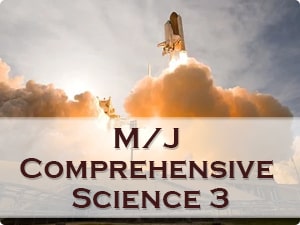
This course is the comprehensive study of concepts and principles related to the field of Science. Topics in this course include: Celestial Objects and their Distances, Galaxies, Gravity and the Solar System, Hertzsprung Russell Diagram, The Solar System, Historical Models of the Solar System, Impact of Objects in Space, Technology in Exploring Space, Electromagnetic Spectrum, Effects of Space Exploration, Photosynthesis and Cellular Respiration, Carbon Cycle, Science Inquiry, Experimental Repetition and Replication, Particle Motion in Matter, Mass and Weight, The Determination of Density of an Object, Metals, Nonmetals, and Metalloids, Elements, Compounds and Mixtures. The Periodic Table of the Elements, Atomic Structure, Acids, Bases, and Salts, Conservation of Mass, Physical and Chemical Changes, and Influence of Temperature on Chemical Changes.
M/J Physical Science FDE
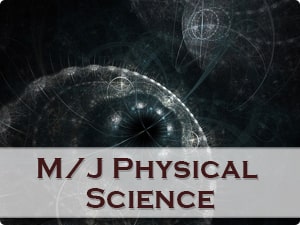
M/J Physical Science delivers instruction, practice, and review to help students develop scientific literacy, deepen conceptual understanding, and apply scientific practices. Students explore concepts including the interactions of matter; motion and stability; waves and their technological applications; and energy.
M/J Comprehensive Science 1, Advanced FDE
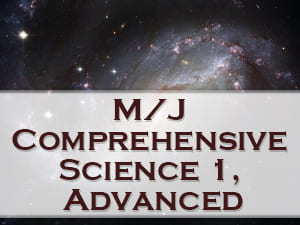
This course is the comprehensive study of concepts and principles related to the field of Science. Topics in this course include: This course is the comprehensive study of concepts and principles related to the field of Science. Topics in this course include: Factors Affecting Health, Geological Processes and Surface Features, Heat Transfer Through Earth's System, Weather, Climate, and Water Cycle, Earth's Spheres, Influences of Solar Energy on the Atmosphere, Effects of Natural Disasters in Florida, Earth's Atmosphere, Biosphere-Levels of Organization, Discovery of the Cell, Homeostasis, Cell Organelles, Body Organization, Communicable Diseases, Classification of Organism, Science Inquiry, Experimental Repetition and Replication, Merits and Demerits of Scientific Investigations, Conservation of Energy, Force and Motion, Types of Forces, and Newton's Law of Gravitation. In addition, the course includes some advanced concepts based on weather prediction and forecasting, membrane transport, mutation, and other concepts involving mathematical and language skills.
M/J Comprehensive Science 2, Advanced FDE
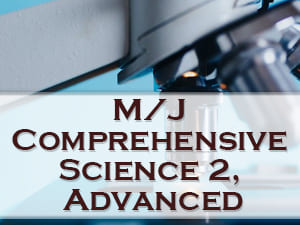
This course is the comprehensive study of concepts and principles related to the field of Science. Topics in this course include: Factors Affecting Health, Communicable Diseases, Structure of Earth, Rock Cycle and Surface Events, Measuring the Age of Earth, Physical Evidences for Earth's Evolution, Plate Tectonics, Impact of Human Activities on Ecosystem, Effects of Mantle Convection, Consistency of Fossil Evidence in Evolution, Genetic Variation and Environmental Factors in Evolution, Heredity and Inheritance, Pedigree Analysis, Reproduction, Impact of Biotechnology, Energy Flow in Ecosystem, Symbiosis, and Limiting Factors, Science inquiry, Experimental Repetition and Replication, Merits and Demerits of Scientific Investigations, Electromagnetic Spectrum, and Reflection and Refraction. In addition, the course includes some advanced concepts based on role of isotopes and gravitational energy in relation to structure of earth, surface features of earth, classification schemes for organisms, natural selection, genetic variation, food web analysis, heat transfer, interaction of matter and energy, and other concepts involving mathematical and language skills.
M/J Comprehensive Science 3, Advanced FDE
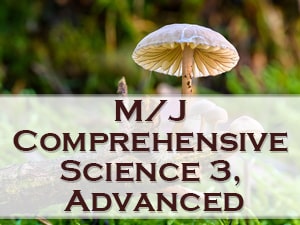
This course is the comprehensive study of concepts and principles related to the field of Science. Topics in this course include: Celestial Objects and their Distances, Galaxies, Gravity and the Solar System, Hertzsprung Russell Diagram, The Solar System, Historical Models of the Solar System, Impact of Objects in Space, Technology in Exploring Space, Electromagnetic Spectrum, Effects of Space Exploration, Photosynthesis and Cellular Respiration, Carbon Cycle, Science Inquiry, Experimental Repetition and Replication, Particle Motion in Matter, Mass and Weight, The Determination of Density of an Object, Metals, Nonmetals, and Metalloids, Elements, Compounds and Mixtures. The Periodic Table of the Elements, Atomic Structure, Acids, Bases, and Salts, Conservation of Mass, Physical and Chemical Changes, and Influence of Temperature on Chemical Changes.
Social Studies
M/J United States History FDE
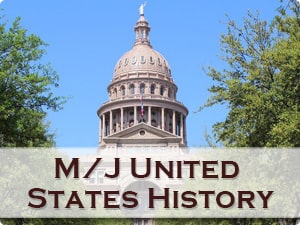
This course is a survey of History of the United States of America beginning with 1877. Topics covered in this course include: Changes on the Western Frontier, A New Industrial Age, The First World War, and the Conflict in Vietnam.
M/J United States History & Civics FDE
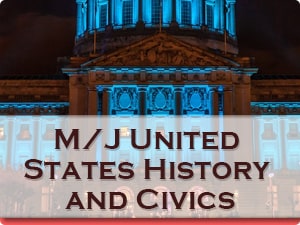
This course focuses on American History from Exploration and Colonization to the Reconstruction Period following the Civil War.
M/J World Geography FDE
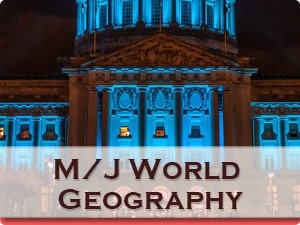
The primary content for this course pertains to the usage of geographic concepts, tools, and skills to draw conclusions about physical and human patterns. Content should include, but not be limited to understanding world political regions in terms of location, physical characteristics, population and culture, historical change, economic activity, and land use. Students will be exposed to the multiple dynamics of geography including economics and world history. Students will study methods of historical inquiry and primary and secondary historical documents.
M/J Social Studies
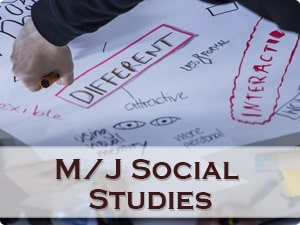
The student will begin their coursework with an extensive review of geographic principles and basic skills. They will continue with the study of the peoples, places, and environments of the Eastern World, with an emphasis on Africa, regions of Asia (Middle East, South Asia, East Asia and SE Asia) and Australia. The knowledge, skills, and perspectives of the course are centered on population and cultural characteristics, landforms and climates, economic and political systems, and migration and settlement patterns within these regions of the world.
Computer Science
M/J Computer Science Discoveries FDE
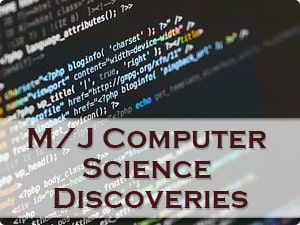
In this course, you will understand how accessibility is an important consideration in the design of any computing system, know the various hardware and software factors that determine the capability of a computing system, use checklists to troubleshoot problems starting from the basics, know how protocols allow different devices to communicate, understand the difference between HTTP and HTTPS and secured information, analyze the difference between data collected by individual devices or by systems, explore how data is represented using characters, numbers, and bits, know how cleaning of data reduces noise and errors, understand how recommendations are predicted using data sets with the help of algorithms, know what variables are and how they are declared, explore the uses of compound and nested conditionals, state how a procedure is a module that performs tasks, employ user-centered designs to create solutions that can impact the society, feel the effect of globalization and the impacts of online piracy, and know how social networking can lead to social engineering and other unauthorized access to information.
M/J Computer Science Discoveries 1 FDE
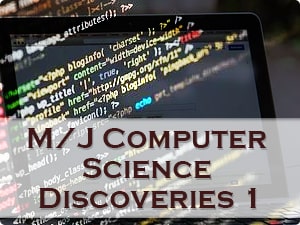
This is an introductory computer science course that empowers students to create authentic artifacts and engage with computer science as a medium for creativity, communication, problem solving, and fun.
M/J Computer Science Discoveries 2 FDE
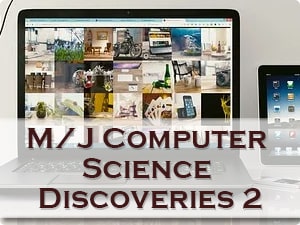
This course focuses on the study of computers and algorithmic processes, including their principles and hardware.
2023 ©
Grade Results
